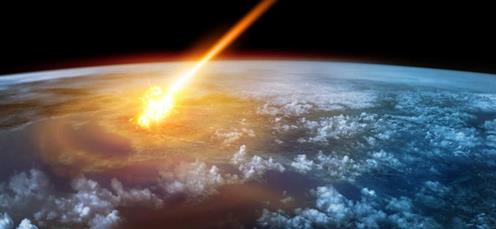When the cosmos shoots pool, it plays for keeps. It sank a six-mile-wide rock in our pocket of the solar system 66 million years ago. The smack of the asteroid against Earth released energy on the order of billions of atomic bombs. Dinosaurs were the cataclysm's most famous victims, joined by sea creatures, plants and microorganisms. All told, Earth's biodiversity shrank by 75 percent in what is known as the Cretaceous-Paleogene, or K-Pg, extinction (also known as the K-T extinction).
A large asteroid strike happens only once every 100 million years. And a controversial new report suggests the K-Pg impact was an exceptionally unlikely shot. In a paper published Thursday in the journal Scientific Reports, a pair of researchers calculated the asteroid had little more than a 1-in-10 chance of triggering a mass extinction when it smacked into Earth. (We mammals should be glad it beat the odds: After the dinosaurs' swift exit, nocturnal furballs — our ancestors — scampered into the daylight and conquered the planet. And one branch of dinosaurs survived and persists as today's birds.)
Soot was the impact's most lethal symptom, argued paleontologist Kunio Kaiho, of Tohoku University, and Naga Oshima, an atmospheric chemist at Japan's Meteorological Research Institute. The asteroid hit Earth near the Yucatán Peninsula in Mexico. There, the researchers say, vast reservoirs of crude oil and hydrocarbons were tucked beneath a shallow sea, waiting to be set ablaze.
Kaiho and Oshima's previous work, published in 2016, modeled what would happen if an asteroid turned lots of organic matter into soot — millions and millions of tons of it, injected into the stratosphere. In the scenario, Earth's temperature plunged beneath the soot cloud that blocked the sun's radiation. Plants, trapped in this carbon choke hold, wilted and died. Starving animals soon followed suit.
Sixty-six million years ago, only 13 percent of Earth's surface contained enough organic material to generate this doomsday soot, the authors concluded in the new study. Had the asteroid hit the other 87 percent of Earth, Kaiho said, “I think dinosaurs could be alive today.”
Timothy Bralower, a Pennsylvania State University paleoceanographer who was not involved with this work, applauded the researchers for their “innovative way of thinking.” But Bralower said he doubted that a soot cloud alone could explain why the asteroid was so lethal.
“The 13 percent number they're quoting has a lot of assumptions based around it,” said Sean Gulick, a geophysicist at the University of Texas at Austin. The asteroid churned up soot, he said, but soot was “not the driver” that killed the dinosaurs.
The extinction asteroid theory, widely accepted as the most plausible explanation for the dinosaurs' disappearance, is the result of four decades of research. In the late 1970s, scientists Luis and Walter Alvarez, a father-son duo at the University of California at Berkeley, began to investigate rocks on the border between the Cretaceous and Paleogene geologic periods. The Alvarez team discovered the element iridium, at levels found only in asteroids, in Italian clay that dated to the ancient divide. Cretaceous soot, too, was mixed in with the red clay.
ridium appeared in 66-million-year-old clay around the world, in locations as far apart as Tunisia and New Zealand. In 1990, scientists announced they'd found the entry wound. It was a giant pockmark in the Yucatán Peninsula, the “Crater of Doom,” centered near a small Mexican town named Chicxulub.
Kaiho and Oshima based their soot cloud calculations on geologic layers in Haiti, near the peninsula. In the late Cretaceous, these rocks were rich in hydrocarbons. That, they said, was the ammunition the asteroid needed. “If the asteroid had hit a low-medium hydrocarbon area on Earth (occupying approximately 87 percent of the Earth’s surface), mass extinction could not have occurred,” Kaiho said.
But Gulick, part of a 2016 drilling project to explore the asteroid's crater, said there was little evidence for sufficient amounts of organic matter at the Chicxulub impact site.
Scientists have found a diary of horrors burned into geologic layers at the time of impact. Hypothesized “kill mechanisms” include toxic heavy metals brought by the asteroid, acidic oceans (so corrosive that animal shells dissolved) and global firestorms. Red-hot asteroid bits, kicked up in the collision, would have rained down on forests and started wildfires across the planet. This might explain the soot found in the clay, Bralower said.
The K-Pg extinction was not the result of one blow but a “quadruple whammy,” he said. “I just don't think, with the diversity of life, one mechanism can explain all the mass extinction.”
All the researchers agreed that the location, at Chicxulub, was crucial to its devastation. “The authors of the study are correct in making the point that you couldn't have hit just anywhere,” Gulick said.
Both Bralower and Gulick pointed to a recent paper in Geophysical Research Letters — they are listed as participants or third-party scientists — which contends that the asteroid released killer amounts not of soot, but of gas. Carbon dioxide and sulfur gases blown extremely high into the atmosphere would have the opposite of a greenhouse effect: surface temperatures plummeting by more than 20 degrees Celsius, or about 40 degrees Fahrenheit.
“If you cool the planet by 26 degrees Celsius in five years you're going to cause a lot of extinction,” Bralower said. To release these climate-altering gases, the asteroid needed to hit a shallow sea above sedimentary rock. In other words, the asteroid would have had to strike a place just like Chicxulub.
Chicxulub..jpg)
Downvoting a post can decrease pending rewards and make it less visible. Common reasons:
Submit
Hi! I am a robot. I just upvoted you! I found similar content that readers might be interested in:
https://www.ndtv.com/world-news/dinosaurs-would-have-survived-if-asteroid-hit-earth-elsewhere-scientists-claim-1773515
Downvoting a post can decrease pending rewards and make it less visible. Common reasons:
Submit